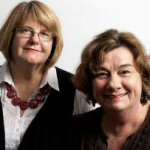
Get Out of the Way and Let Them Play
The best prescription for healthy play begins outdoors
by Mary Jane Sterne and Peggy Edwards
Do you remember playing outside until the street lights came on? Exploring paths and riverbanks near your house; playing dodge ball in the schoolyard at recess; climbing trees and balancing on fallen logs in the park; riding your bike to school; playing hide and seek in your neighbourhood; getting dirty when you roughhoused with your brother in the wet grass; and drinking water out of an outdoor hose on a hot summer day?
All of that unstructured outdoor play helped us become fit and resilient, to feel more confident, develop skills, solve problems, to enjoy and understand nature and to learn our limits.
Today, much of what we considered normal and exciting play is called “risky play” due to fear of injury, lawsuits or abduction. Playgrounds designed to be “safe” have become boring and uninteresting. Schools cancel outdoor play in snowy or rainy weather for fear of slipping. Some have banned ball play in the yard for fear of injury.Certain municipalities have banned street hockey and stopped investing in natural play spaces for fear of frivolous lawsuits over minor injuries related to active outdoor play.
Parents and grandparents drive their children everywhere because of unsubstantiated fears related to safety, particularly kidnapping (“stranger danger”), and collisions with cars. Pedestrian injuries do happen, but according to the latest research, it is eight times more likely a child will be seriously injured while travelling in a car than outside of one. As for kidnappings, RCMP reports show there is a one in 14 million chance of a child in Canada being kidnapped by a stranger.
The latest ParticipACTION Report Card on physical activity for children and youth gives us a D- when it comes to supporting active outdoor play. In an era of bans on schoolyard ball play, street hockey and tobogganing, have parents, grandparents and society lost the balance between keeping children healthy and active and protecting them from serious harm? If we make too many rules about what children can and cannot do, will we hinder their natural ability to develop and learn?
ParticipACTION, along with other key organizations such as the Children’s Hospital of Eastern Ontario, have developed a Position Statement which applies to boys and girls aged three to 12. It makes recommendations to parents, educators and caregivers, health professionals, schools and governments on how to increase children with opportunities for children to engage in healthy, active outdoor play.
Ideas for grandparents, parents and caregivers
Expose your grandchildren to natural outdoor environments—walking, hiking, and playing in woods, fields and hills. Take them boating, camping, fishing, berry picking, birdwatching and frog hunting.
Take your grandchildren to parks that have natural elements (e.g., fields, wooded areas, hills and rocks), not just prefabricated playgrounds and paved areas. Children are more curious in unstructured natural outdoor play spaces. Encourage them to run, climb, explore and observe birds, vegetation, insects and small animals. Have your grandchild bring a friend. Playing outdoors with others builds social skills and is more fun with others.
Encourage grandchildren to play outside in all weather conditions.When they visit, ask them to bring clothes and footwear suitable for playing outside in warm, cold, and wet weather (including dry clothes to change into after being outside). Be prepared to go out with them. Encourage them to build forts and other structures made of snow or natural materials.
Don’t over-supervise.When children are closely supervised outside, they are less active, more fearful, and not as connected to nature.
Refrain from shouting anxiety-laden warnings such as, “Be careful!”, “Get down!” and “Watch out!” When you say these things a child hears, “The world is a dangerous place.You don’t trust me to navigate that world. I can’t be independent.”
Limit the time your grandchildren spend sitting in front of screens.They are more likely to be exposed to violence and cyber-predators when spending many hours with computer, television, and movie screens than they are to predators and violence when playing outside. Screen time and sitting is also associated with eating unhealthy snacks, being overweight, and the long-term development of heart disease and diabetes.
Walk to the library or take public transit and walk partway. Encourage them to explore and observe along the route.
Teach your grandchildren how to safely move around in your neighbourhood, at your cottage, and other outdoor environments. Once you feel confident they know how to handle crossing the road,or how to safely get to the neighbourhood park, you’ll both feel better about giving them more autonomy.
Recognize that children are competent and capable.When we button our lips, we see that children are actually quite capable of figuring out their limits.
Talk with parents about their assessments of their children’s abilities and their decisions to encourage self-directed play out-of-doors.
Recognize the difference between danger and risk. Value fun and long-term health as much as we value safety.When children are supported in taking manageable risks, they have more fun and learn how to assess and manage risks in all areas of their lives.
Mariana Brussoni, an injury-prevention expert based at the University of British Columbia’s school of public health, suggests it is just as important to look at the benefits of active outdoor risky play as it is to worry about unlikely injuries. “Beyond increased levels of activity and improved social behaviour, studies show benefits I wouldn’t have expected, such as better skills in conflict resolution.”
Our generation is lucky to have grown up with the thrills and fun of self-directed outdoor play. Let’s help our grandchildren experience the same. n
 Peggy Edwards and Mary Jane Sterne are authors of Intentional Grandparenting: A Boomer’s Guide (McClelland and Stewart, 2005). The authors live in Ottawa and have 23 grandchildren and five great-grandchildren between them.
Peggy Edwards and Mary Jane Sterne are authors of Intentional Grandparenting: A Boomer’s Guide (McClelland and Stewart, 2005). The authors live in Ottawa and have 23 grandchildren and five great-grandchildren between them.






